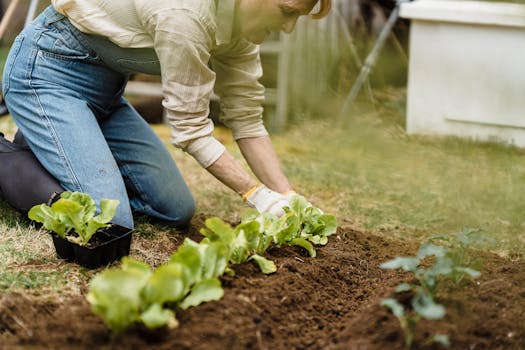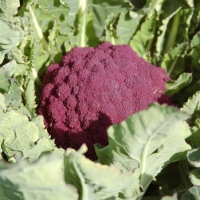
It’s worth learning how to grow cauliflower properly, it’s popular, tasty and nourishing! A more difficult vegetable to grow but most failure is due to poor preparation.
So your first prioroity when you first learn how to grow cauliflower is to make sure you give them a rich and deep soil during the growing season – with no check in the cauliflowers growth.
Let me emphasise this point – proper soil preparation, careful planting and regular watering are not only very important but essential. Failure to carry out these basic husbandry measures when learning how to grow cauliflower will mean the production of tiny ‘button’ heads and frustration at your wasted effort.
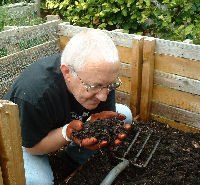
How to Grow Cauliflower – Soil Details
As mentioned above, when learning how to grow cauliflower it is important to remember they require a firm, fertile soil as the main cause of failure – button heads – is loose, infertile soil. This is where a fairly heavy soil is an advantage to the vegetable grower. Try choosing a bed that is in a reasonably sunny spot in which to plant your cauliflower vegetables.
Using the three year crop rotation is ideal as you can plant them where peas and beans grew the previous year as their soil should have manure or compost dug in. If that was the case, no more need be dug in.
If that is not the case and your soil is poor, dig in plenty of well rotted compost or manure as early in the autumn as possible in order to give the the soil maximum time to settle.
This enables the essential firmness to become establish, whilst having that all important fertility… remember – feed the soil not the plant! – an essential first tip if you are just starting to learn how to grow cauliflower.
Thats me in the photo… just about to have breakfast mmmMMM – lets hear it for living soil!
Acid soils encourage club root, a terrible disease of the brassica family which gardeners fear, so make sure you add lime to get a pH of about 6.5 to 7.0 – this is not rocket science.
So for those who want to know how to grow cauliflowers without the guesswork just get yourself a pH meter or soil testing kit and follow the instructions. It’s always a sensible move to get to know all the facts you can about your soil.
Apply a dressing of a general fertiliser like Growmore in the spring, two or three weeks before transplanting your cauliflower plants. Don’t dig it in but rake gently over the surface as you will want to keep the bed firm.
How to Grow Cauliflower – Sowing Seed
Cauliflowers are quite often raised in an outdoor seed bed for transplanting into their permanent beds later. Again a very fertile soil is required to give the plants a good start.
How to Grow Cauliflower – Making a Seed Bed
In early spring rake over and level the area you have chosen as a seed bed – frosts will have done a lot of the work for you by then… hopefully. If you only require a few plants then this need not be too big an area.
Cover the bed with sifted mature compost – the bed may be small enough to purchase a bag or two from your garden centre, especially if you’re just getting to know how to grow cauliflower, you might not have the organic matter to compost. Tread over this to make it firm… but only when the soil is dry enough i.e. not sticking to your boots. Then give it a light raking over.

Mark out the rows using string stretched between two stakes for a straight line and make shallow drills along the length of the How to Grow Cauliflower string with a trowel 13mm(1/2″) deep and rows 15cm(6″) apart.
Sow the seed thinly into the drills and cover them over with soil, lightly firming with the head of the rake. Mark both ends of the row, labelling one end with the variety and date of sowing. Keep the seed bed moist, always use a fine spray.
When the cauliflower plants are about 2.5cm(1″) tall, thin the seedlings to about 7.5cm(3″) apart in the rows. This is to stop overcrowding thus causing the seedlings to become weak and spindly.
The seedlings are ready to plant out when they are about 10cm(4″) to 15cm(6″) tall or have 5 or 6 leaves. Water the bed the previous day before removing them to their permanent position.
When your learning how to grow cauliflower there is no need to remember which varieties to grow of: summer, autumn or winter. Part of the enjoyment of growing vegetables is to get hold of some of those amazing seed catalogues (they’re sent out free) and get to know what is available.
Then make your choice… especially around a nice cosy fire. The anticipation really energises you for the coming spring.
But as a rule-of-thumb:
| Sow summer varieties of cauliflower under glass in mid January and transplant outdoors in late March for a crop in June/July. Sow outdoors in early April and transplant in June for a crop in August/September.
Sow autumn varieties of cauliflower outdoors between mid April and mid May transplanting them in late June. Sow winter varieties of cauliflower in May for transplanting in late July. In the UK growing cauliflower in winter is usually only successful in the south/west – Devon and Cornwall especially. For more northerly areas it will always be a risk. |
How to Grow Cauliflower – Sowing Seed Into Trays
As ever, when learning how to grow cauliflower or any vegetable, there are other ways to achieve the same outcome. So if you have a greenhouse, cold frame or cloches – growing cauliflower from seed can be made easier and more convenient if you don’t have a large garden to accomodate a seed bed.
Sow cauliflower seed in a tray filled with seed compost bought from your local gardening centre. Water thoroughly and place them inside one of the above (cloche etc…). When the first two leaves have formed prick them out into 7.5cm(3″) pots filled with potting compost – firm in the roots.
Remember transplanting cauliflowers is different from other brassicas (cabbage, brussel sprouts etc). Put this in your – how to grow cauliflower – notebook; don’t transplant them into these pots or into their final growing position any deeper than they were in the seed tray or seed bed (if sown oudoors) and take with it as much soil around the roots as possible.
water in well. Leave plants to grow on until tall enough for transplanting into their final positions by following the growing instructions above.
For a more detailed description of how to sow seed into trays click here – Sowing Seed – This will open the web page into a new window.
How to Grow Cauliflower – Planting Out
The place you have chosen as your permanent bed for your cauliflower is best in full sun. Water your plants the day before you aim to transplant them into that well-firmed bed you prepared last autumn, all ready to settle down for their growth to maturity.

Transplant the cauliflower plants in the evening to minimise distress and to make a quicker recovery – keep as much soil around the roots as you can as this is very important with cauliflower plants.
Use two stakes with string stretched between them like you did on the seed bed, mark out a straight line. Make a hole with a trowel or dibber large enough to take the root ball. Plant the seedlings to the same level as they were in the seed tray or seed bed – remember!
If you’re just starting to learn how to grow cauliflower and you want to be a bit geeky, the bottom two leaves are called cotyledons or ‘seed leaves’ Firm the soil around each plant with your hands or the dibber. Remember – firm planting helps to grow firm, tight cauliflower heads.
Note Well... an important point to remember when learning how to grow cauliflower is that transplanting is necessary. Planting out seedlings from pots or seed beds encourages a stronger root system to be established in their permanent bed.
Leave 60cm(24″) between summer and autumn varieties and 75cm(30″) between winter varieties. Don’t forget, all this information will be on the seed packet – you can’t go wrong. Water well after transplanting.
The spacing is important but it does not have to be wasted space. Plant quick-growing crops in between like lettuce, salad leaves and many others.
How to Grow Cauliflower – Caring for Your Plants
Hoe regularly to keep down weeds but don’t loosen the soil to deeply – a firm bed… remember.
Cauliflower plants must never be kept short of water – easpecially as young plants – otherwise small premature ‘button heads’ will soon form.
One major enemy of your attempt to grow vegetables are birds – especially in country gardens, they seem like cauliflower plants. Protect the smaller plants from sparrows and the bigger mature plants from wood pigeons.
Apply a foliar feed during summer as the cauliflower plants respond very well to this as they are hungry ‘beasts’. Far more nutrients are absorbed than by feeding at the roots.
Two other menaces that can have a bad impact on your plants are caterpillars and aphids. See ways of dealing with these pests below and what safe nematode pest control products are available.
For summer varieties break a few leaves over the developing curd to protect it from the sun. Should you be growing winter varieties then do the same to protect the curd from frost and snow damage.
How to Grow Cauliflower – Pest Control
 |
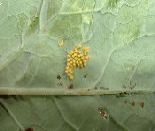 |
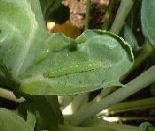 |
| Mealy Aphids are a serious pest, weakening your cauliflower plants and introducing viruses which further weaken plants. Talk with your garden centre for what might be effective. | Eggs of the Large White butterfly. Caterpillars can defoliate a plant quickly so watch out for them. Inspect the underside of the leaves for clusters and squish them. Practice your tennis strokes when the butterfly is about | Caterpillar of the Small White butterfly. Defoliates plants quickly, watch out for them. Pick off and destroy, use a nematode spray. Eggs are laid under leaves in a random way, not in clusters, nor are they brightly coloured. |
Knowing how to grow cauliflower to minimise pest problems will mean following some sort of crop rotation plan.
This simply means not growing vegetables of the same family in the same piece of earth year after year…it encourages pest build up in the soil. For cauliflower this means – broccoli, cabbage, kohlrabi, turnip, brussels sprouts.
Whether you are a seasoned vegetable grower or are just starting to learn how to grow cauliflower or any vegetable – pests and diseases don’t care… so get to know your enemy.
Cabbage root fly can be a problem so use protective discs at the base of the cauliflower plants as they lay their eggs in the soil at this point.
These can be made from old bits of hessian backed carpet, underlay or roofing felt – use your imagination. Also cover with gardening fleece when the plants are young.
Fleece is a great friend to the gardener, it allows rain and light through but insulates against frost and deters pests.
Keep a watchfull eye for the appearance of caterpillars as left unattended they will devastate your cauliflower plants.
They feed on the underside of the leaves and the best answere is to just pick them off and… squish ’em. They also lay their eggs there too so look for yellow clusters aannndddd… squish ’em. If you you have’nt the time to keep squishing – or the stomach (sorry but this is all part of how to grow cauliflower), then use a nematode spray.
It uses nematodes to provide an environmentally safe and efficient treatment which can be watered straight onto edible plants. Use ‘Just Caterpillar’ once they are seen on the plant, preferably whilst they are still small, and the nematodes will quickly seek out the caterpillar and kill it.
Club root is a fungus and all brassicas (thats the family umberalla for cauliflower along with broccoli, cabbage, kohlrabi, turnip, brussels sprouts) can be affected. The roots become stubby and swollen. Leaves become yellow and wilt causing severe stunting of growth. This causes swelling of the roots and reduces the flow of water and nutrients to the plant.
Spores are produced and can survive in the soil for up to five years.
Prevent club root by practicing crop rotation and take extreme care if you buy in seedlings from outside as this is often the way this fungus is introduced. Reducing the acidity of the soil by adding lime will help.
Aphids can be a serious pest by weakening your cauliflower plants and introducing viruses. Try planting Marigolds or Tagetes plants among the crop.
They attract beneficial insects like hover flies and lady birds which feed on the aphids and will help reduce the infestation – yet another aspect of learning how to grow cauliflower is to understand how nature can be used to benefit your environment.
Vast changes have taken place in the UK and Europe concerning the availability of pesticides during recent years. Visit your garden centre or nursery and seek their advice as what to use.
Flea Beatles are tiny beetles that can make sieves out of your brassica leaves. When you touch the brussel sprout leaves they ping off just like regular fleas, only these won’t bite you! To deter them:
Use horticultural fleece placed over your brussels sprouts, as soon as you transplant them outside; a floating row cover.
Lightly hoe over the soil regularly to destroy eggs and larvae and expose them to predators.
Give your plants a midday shower with the hose (not in full sun though), as they’re most active then and they don’t like wet conditions.
Try ‘Companion Planting’, to attract the beneficial insects.
How to Grow Cauliflower – Harvesting

It is best to begin cutting some of the heads whilst they are still fairly small. Waiting for them all to mature will mean you will have a glut of cauliflower curds.
If the individual florets which make up the head or curd of the plant begin to sperate then you have waited too long to harvest it.
It is possible to keep the heads up to two or three weeks after harvesting and before being used. Lift the cauliflower plant, shake the soil off the roots and hang upside down in a cool place. Spray them regularly with water.
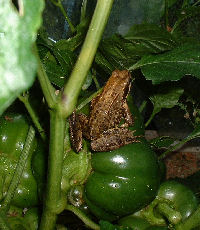 |
This is me and my greenhouse buddy – Freddie Frog signing off. We’ll be back updating and adding more pages so don’t forget to ‘contact us’ and let us know what you would like adding to the site. Don’t forget to visit the other pages too. |
Article source: https://www.vegetable-garden-guide.com/how-to-grow-cauliflower.html
